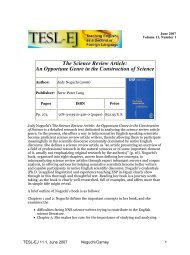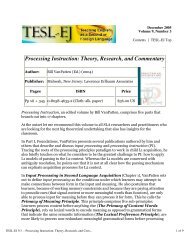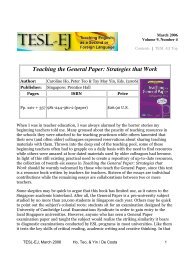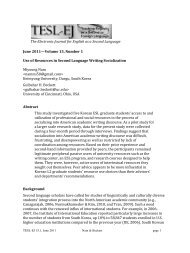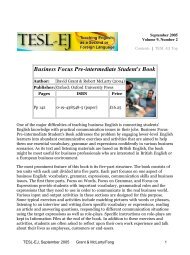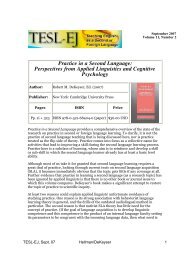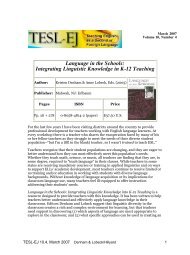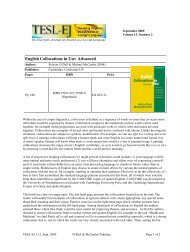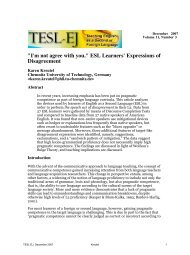TESL-EJ 10.4 -- Real Talk 1: Authentic English in Context
TESL-EJ 10.4 -- Real Talk 1: Authentic English in Context
TESL-EJ 10.4 -- Real Talk 1: Authentic English in Context
Create successful ePaper yourself
Turn your PDF publications into a flip-book with our unique Google optimized e-Paper software.
March 2007<br />
Volume 10, Number 4<br />
<strong>Real</strong> <strong>Talk</strong> 1: <strong>Authentic</strong> <strong>English</strong> <strong>in</strong> <strong>Context</strong><br />
Author: Lida Baker & Judith Tanka (2006)<br />
Publisher:<br />
White Pla<strong>in</strong>s, NY: Pearson Education<br />
Title Pages ISBN Price<br />
Student book Pp. x + 260<br />
Audio CDs<br />
Teacher's<br />
Manual with<br />
Answer Key and<br />
Tests<br />
Runn<strong>in</strong>g time:<br />
181m<strong>in</strong> 41secs<br />
Pp. 136<br />
0-13-183545-9<br />
(paper)<br />
0-13-194547-5 (3<br />
CDs)<br />
0-13-194554-8<br />
(paper)<br />
$37.27<br />
U.S.<br />
$55.33<br />
U.S.<br />
$13.33<br />
U.S.<br />
How many times have you f<strong>in</strong>ished listen<strong>in</strong>g to a textbook's recorded dialogue and<br />
felt compelled to po<strong>in</strong>t out to your students that some of the language used was not<br />
really natural <strong>English</strong>, but, rather, was simply used <strong>in</strong> order to highlight a particular<br />
grammar construction or hypothetical situation students may one day encounter? I<br />
imag<strong>in</strong>e that most ESL/EFL teachers have struggled with this dilemma at some<br />
po<strong>in</strong>t <strong>in</strong> their teach<strong>in</strong>g career, and many have probably felt that textbook audio<br />
record<strong>in</strong>gs were doomed to rema<strong>in</strong> this way forever. Fortunately, Lida Baker and<br />
Judith Tanka offer an <strong>in</strong>novative approach to the speak<strong>in</strong>g/listen<strong>in</strong>g textbook genre<br />
by <strong>in</strong>clud<strong>in</strong>g authentic samples of recorded <strong>English</strong> <strong>in</strong> genu<strong>in</strong>e contexts. They also<br />
provide a host of activities designed to promote speak<strong>in</strong>g and listen<strong>in</strong>g skills as well<br />
as note-tak<strong>in</strong>g skills.<br />
The book is <strong>in</strong>tended for <strong>in</strong>termediate to high-<strong>in</strong>termediate learners <strong>in</strong> both ESL and<br />
EFL environments and is organized <strong>in</strong>to themed chapters with authentic samples of<br />
<strong>English</strong> serv<strong>in</strong>g as each chapter's base material. Pre-listen<strong>in</strong>g activities are designed<br />
to activate students' background knowledge of the given theme and preview the key<br />
vocabulary of each recorded excerpt. Dur<strong>in</strong>g listen<strong>in</strong>g, there are a number of<br />
exercises aimed at foster<strong>in</strong>g a range of listen<strong>in</strong>g skills from identify<strong>in</strong>g ma<strong>in</strong> ideas to<br />
focus<strong>in</strong>g on specific details and mak<strong>in</strong>g <strong>in</strong>ferences. Pronunciation and language and<br />
vocabulary for specific functions are also highlighted along with basic academic<br />
note-tak<strong>in</strong>g strategies. Post-listen<strong>in</strong>g activities <strong>in</strong>clude a vocabulary review <strong>in</strong> addition<br />
to ample opportunities for student-generated conversation and discussion. The<br />
accompany<strong>in</strong>g Audio CDs are essential <strong>in</strong> order to use this textbook and consist of 3<br />
<strong>TESL</strong>-<strong>EJ</strong> <strong>10.4</strong>, March 2007 Baker & Tanka/McDonald 1
hours of listen<strong>in</strong>g. The Teacher's Manual provides general teach<strong>in</strong>g tips and<br />
suggestions, answer keys for all activities, and additional chapter tests.<br />
<strong>Real</strong> <strong>Talk</strong> 1 has eight chapters:<br />
1.<br />
2.<br />
3.<br />
4.<br />
5.<br />
6.<br />
7.<br />
8.<br />
What's <strong>in</strong> a Name?<br />
Let's Get Away!<br />
Look<strong>in</strong>g for Love<br />
Music to My Ears<br />
Gett<strong>in</strong>g the Job Done<br />
To Your Health!<br />
Shop 'til You Drop<br />
Do the Right Th<strong>in</strong>g.<br />
The chapters are not cumulative; therefore it would be possible to change the order<br />
for classroom use or skip entire chapters altogether. Each chapter is further divided<br />
<strong>in</strong>to four parts which correlate with the four audio record<strong>in</strong>gs for each given chapter.<br />
The four parts of each chapter follow a set order chosen to represent the most<br />
common contexts of spoken <strong>English</strong> and are named accord<strong>in</strong>gly: "In Person", "On the<br />
Phone", "On the Air", and "In Class". The audio record<strong>in</strong>gs themselves, therefore, are<br />
the foundation of each part and are the dist<strong>in</strong>guish<strong>in</strong>g element of this textbook. As<br />
implied by the name, "In Person" record<strong>in</strong>gs are face-to-face conversations, surveys<br />
or <strong>in</strong>terviews. "On the Phone" record<strong>in</strong>gs consist of phone conversations between a<br />
customer and a customer service representative, often follow<strong>in</strong>g recorded<br />
announcements, as is so common today. The record<strong>in</strong>gs for the "On the Air" portions<br />
of each chapter are taken directly from radio programs. F<strong>in</strong>ally, the "In Class"<br />
record<strong>in</strong>gs <strong>in</strong>clude short, four- to six-m<strong>in</strong>ute, academic lectures related to the<br />
chapter theme.<br />
While <strong>Real</strong> <strong>Talk</strong> 1's use of authentic record<strong>in</strong>gs <strong>in</strong> various contexts sounds highly<br />
appeal<strong>in</strong>g, the real question is how well it works with its <strong>in</strong>tended audience of<br />
students. To f<strong>in</strong>d out, I tried several chapters with my undergraduate,<br />
<strong>in</strong>termediate-level EFL communication classes at a large Japanese university. These<br />
communication classes are focused primarily on speak<strong>in</strong>g and listen<strong>in</strong>g and<br />
traditionally <strong>in</strong>clude a fair amount of listen<strong>in</strong>g practice via recorded conversations<br />
and lectures as well as related opportunities for student conversation. In that sense,<br />
the overall format of <strong>Real</strong> <strong>Talk</strong> 1 was not new to my students, and it was relatively<br />
easy to <strong>in</strong>tegrate <strong>in</strong>to the course syllabi.<br />
Despite such familiarity and ease of <strong>in</strong>tegration, the book's usefulness proved to be<br />
quite limited for this specific learn<strong>in</strong>g context. Foremost, the textbook's level is<br />
significantly higher than advertised. The note to the teacher prefac<strong>in</strong>g the student<br />
textbook claims that "the book is designed for students at the <strong>in</strong>termediate to<br />
high-<strong>in</strong>termediate level <strong>in</strong> both second- and foreign-language environments" (p. viii),<br />
while this claim is contradicted by the accompany<strong>in</strong>g Teacher's Manual which states<br />
that "the text is designed for students at the high <strong>in</strong>termediate level . . ." (p. 1).<br />
Perhaps the description <strong>in</strong> the Teacher's Manual is accurate, though I would go so far<br />
as to classify the level as high-<strong>in</strong>termediate to advanced. Given that all the record<strong>in</strong>gs<br />
are labeled authentic, it makes sense that the level approximates that of native<br />
speakers. In my classes, the pre-listen<strong>in</strong>g activities were not enough support to<br />
prepare my students to listen to this level of <strong>English</strong> effectively and many students<br />
<strong>TESL</strong>-<strong>EJ</strong> <strong>10.4</strong>, March 2007 Baker & Tanka/McDonald 2
were noticeably discouraged while listen<strong>in</strong>g.<br />
Another major concern that arose when us<strong>in</strong>g <strong>Real</strong> <strong>Talk</strong> 1 with my classes was how<br />
poorly suited the textbook is for the EFL student audience. Although the textbook is<br />
billed as appropriate for both "second- and foreign-language environments" as noted<br />
previously (p. viii), there are several issues which make it <strong>in</strong>compatible with most<br />
EFL classes. First, a number of the speak<strong>in</strong>g opportunities throughout the text center<br />
around students discuss<strong>in</strong>g national or cultural viewpo<strong>in</strong>ts. As my classes are<br />
completely homogeneous, as a good portion of EFL classes are, these discussions did<br />
not work as written and demanded either significant adaptation or a more<br />
teacher-centered discussion.<br />
Furthermore, a dist<strong>in</strong>ctive attribute of the book, the authentic record<strong>in</strong>gs from four<br />
contexts, are also not entirely applicable to EFL sett<strong>in</strong>gs. Though most of the "In<br />
Person" chapter parts could be used <strong>in</strong> advanced EFL classes, the other chapter parts<br />
("On the Phone", "On the Air", and "In Class") would be irrelevant to most EFL<br />
students who do not plan on study<strong>in</strong>g or liv<strong>in</strong>g <strong>in</strong> an <strong>English</strong>-speak<strong>in</strong>g country. S<strong>in</strong>ce<br />
the "On the Phone" segments feature a customer connected with a customer service<br />
agent <strong>in</strong> a dist<strong>in</strong>ctly North American context, they were largely unrelated to my EFL<br />
students' experiences us<strong>in</strong>g <strong>English</strong> and decidedly not of <strong>in</strong>terest. To a lesser degree<br />
both the "On the Air" and "In Class" selections were hard for my students to relate<br />
to, though they would likely be much more mean<strong>in</strong>gful to ESL students study<strong>in</strong>g and<br />
liv<strong>in</strong>g <strong>in</strong> an <strong>English</strong>-speak<strong>in</strong>g country. While the authors claim that the record<strong>in</strong>gs<br />
represent "the four contexts <strong>in</strong> which spoken <strong>English</strong> normally occurs" (Teacher's<br />
Manual, p. 1), it seems that these contexts may be more <strong>in</strong> l<strong>in</strong>e with what ESL<br />
speakers will encounter. In the case of EFL students, perhaps contexts like television<br />
shows and movies or onl<strong>in</strong>e audio- and video-conferences would be more pert<strong>in</strong>ent<br />
and, therefore, more mean<strong>in</strong>gful to such students.<br />
On the whole, Baker and Tanka do provide a wealth of authentic <strong>English</strong> record<strong>in</strong>gs<br />
<strong>in</strong> the four contexts targeted. Teachers and students alike will f<strong>in</strong>d the natural style of<br />
the record<strong>in</strong>gs, <strong>in</strong>clud<strong>in</strong>g all of the "false starts, fillers, hesitations, repetitions, and<br />
errors" (p. viii), extremely refresh<strong>in</strong>g, especially <strong>in</strong> contrast with typical stilted<br />
speak<strong>in</strong>g and listen<strong>in</strong>g textbook record<strong>in</strong>gs. The authentic record<strong>in</strong>gs and <strong>in</strong>terest<strong>in</strong>g<br />
chapter themes also serve as a sturdy base for the designed activities or any number<br />
of opportunities for expansion either <strong>in</strong> class or out. While EFL teachers will<br />
probably f<strong>in</strong>d this textbook limited by its difficultness, its frequent use of cultural<br />
differences between students to generate discussion, and record<strong>in</strong>g contexts that<br />
demand a degree of familiarity not yet held by most EFL students, ESL teachers<br />
should f<strong>in</strong>d <strong>Real</strong> <strong>Talk</strong> 1 an <strong>in</strong>novative option for high-<strong>in</strong>termediate to advanced<br />
speak<strong>in</strong>g and listen<strong>in</strong>g classes--def<strong>in</strong>itely worth a look and listen.<br />
Kurtis McDonald<br />
Kwansei Gaku<strong>in</strong> University, Japan<br />
<br />
© Copyright rests with authors. Please cite <strong>TESL</strong>-<strong>EJ</strong> appropriately.<br />
<strong>TESL</strong>-<strong>EJ</strong> <strong>10.4</strong>, March 2007 Baker & Tanka/McDonald 3



